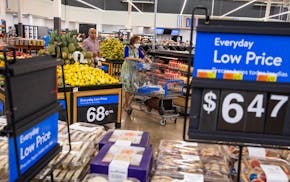General Mills is putting "Cinnadust" on everything — and it is working sales magic.
Sales of Cinnamon Toast Crunch are up 20% over the past year as the nation's second-best-selling cereal (behind Honey Nut Cheerios) benefits from a concerted effort to bolster its visibility by marketing and promoting the cinnamon-sugar flavor on its non-cereal products.
"We've got Cinnamon Toast Crunch churros, minis, Betty Crocker deserts and frostings, and that's all done incredibly well for us too," said Jon Nudi, president of North American Retail for General Mills. "We're also bringing our 'Cinnamojis' to life in pop culture, tying in with celebrities and showing up at professional sporting events."
The Golden Valley-based company has multiplied its marketing budget for North American retail, the largest part of General Mills' business. General Mills expects to increase its ad spending by double digits through the end of the fiscal year — a significant bump compared to its more typical increases of 5% in recent years.
"We believe healthy investment in brands, even in periods of volatility, is critical for long-term growth," CEO Jeff Harmening said at an investor conference Tuesday.
General Mills also has more money to spend on advertising thanks to several years of unusually high revenue and profit growth. On Tuesday, General Mills increased its financial outlook for the rest of the fiscal year, which ends in May. Sales are expected to grow 10% over last year, the largest annual jump in a decade and potentially putting the company over the $20 billion mark for the first time ever.
Competitors have noted the increased "advertising intensity."
"I think we need that kind of support in order to maintain interest in the overall [cereal] category," Post Holdings CEO Rob Vitale told analysts in a conference call earlier this month. "We're far more sensitive to promotional intensity than advertising intensity. And I think that's within the normal range."
Until the pandemic hit, cereal sales were slipping and most manufacturers were fighting to maintain profit margins. Sales surged as more shoppers searched out comfort foods and ate more at home during lockdowns and beyond.
General Mills has led the cereal category for several years, with Kellogg close behind and Lakeville-based Post Consumer Brands third.
Nudi said "all our big brands are doing nicely," and the new "mini" versions of popular cereals are in some cases out-performing their parents.
"Consumers like new things and new experiences," Nudi said, though a lot of recent innovation has been extending existing brands. "[They] are voting on who they buy and our job is to be their top pick."
The company's upbeat outlook comes even as price increases have pushed down the number of products the company is selling and on-shelf availability is still below historic norms.
Supply chains haven't fully recovered — Yoplait yogurt was hit with a starch ingredient shortage that kept it off shelves, but that shortage didn't affect other brands, Nudi said.
The big-picture driver for General Mills sales is more eating at home and less eating at restaurants compared to pre-pandemic days, he said.
"When you look at how consumers are spending, they're spending more in grocery stores, which is good for us," Nudi said. "And at the end of the day the consumer is still relatively healthy when looking at savings rates."
Minnesota's med spa industry rises in popularity — and with little regulation

Ramstad: Readers say Walmart won't be paying the ultimate price of Trump's tariffs

How Minnesota businesses can spot and prevent invoice fraud
No place for cryptocurrency in retirement portfolios

